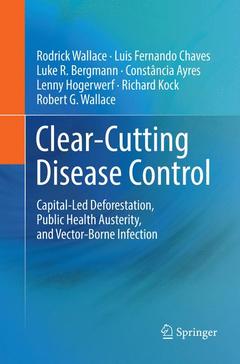Clear-Cutting Disease Control, Softcover reprint of the original 1st ed. 2018 Capital-Led Deforestation, Public Health Austerity, and Vector-Borne Infection
Auteurs : Wallace Rodrick, Chaves Luis Fernando, Bergmann Luke R., Ayres Constância, Hogerwerf Lenny, Kock Richard, Wallace Robert G.

The vector-borne Zika virus joins avian influenza, Ebola, and yellow fever as recent public health crises threatening pandemicity.
By a combination of stochastic modeling and economic geography, this book proposes two key causes together explain the explosive spread of the worst of the vector-borne outbreaks.
Ecosystems in which such pathogens are largely controlled by environmental stochasticity are being drastically streamlined by both agribusiness-led deforestation and deficits in public health and environmental sanitation.
As infectious diseases in an age of nation states and global health programs cannot, as much of the present modeling literature presumes, be described by interacting populations of host, vector, and pathogen alone, a series of control theory models is also introduced here. These models, useful to researchers and health officials alike, explicitly address interactions between government ministries and the pathogens they aim to control.
The Social Context of the Emergence of Vector-Borne Disease.- Modeling Vector-Borne Diseases in a Commoditized Landscape.- Modeling State Interventions.- Implications for Disease Intervention and Modeling.- Mathematical Appendix.- References.
Rodrick Wallace, Division of Epidemiology, New York State Psychiatric Institute at Columbia University
Luis Fernando Chaves, Department of Vector Ecology and Environment, Institute of Tropical Medicine at Nagasaki University
Luke Bergmann, Department of Geography, University of Washington
Constância Ayres, Vice-Director, Fiocruz, Brazil
Lenny Hogerwerf, Centre for Infectious Disease Control, National Institute for Public Health and Environment (RIVM), The Netherlands
Richard Kock, Department of Pathology and Pathogen Biology, Royal Veterinary College, London
Robert G. Wallace, Institute for Global Studies, University of Minnesota
Date de parution : 01-2019
Ouvrage de 68 p.
15.5x23.5 cm
Date de parution : 03-2018
Ouvrage de 68 p.
15.5x23.5 cm



